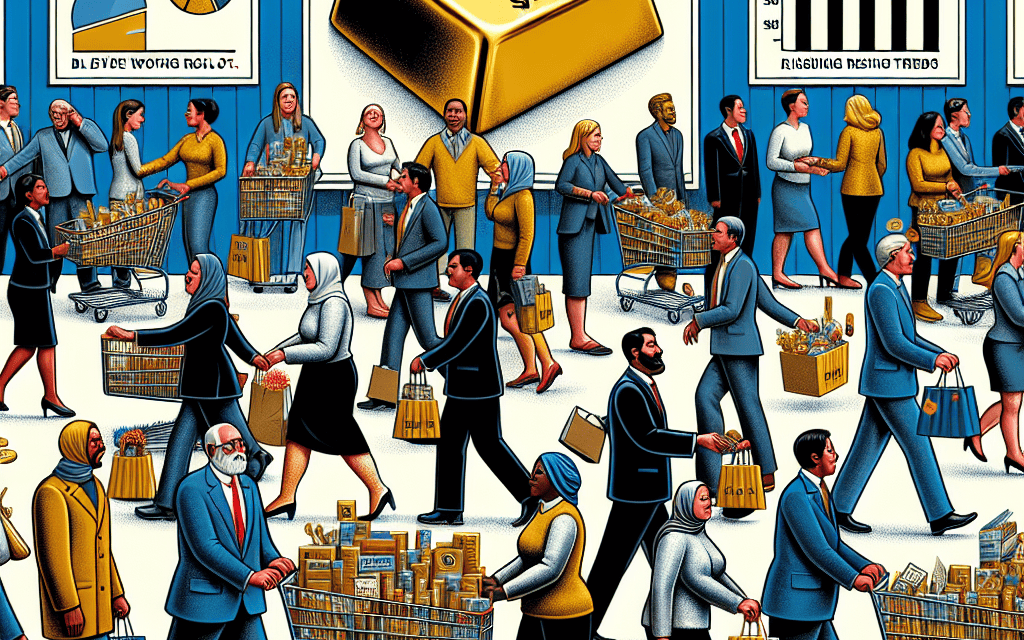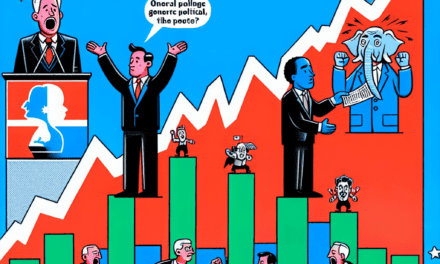“Striking Gold: Decoding the Economic Rush Behind Costco’s Coveted Bars”
Introduction
In recent years, the retail landscape has witnessed a fascinating phenomenon: the Costco gold bar frenzy. This unexpected surge in consumer interest has not only captured the attention of savvy investors but also sparked widespread curiosity about the underlying economic forces at play. As a leading wholesale retailer, Costco’s decision to offer gold bars to its members has unveiled intriguing insights into consumer behavior, market dynamics, and the broader economic environment. By examining the factors driving this gold rush, we can gain a deeper understanding of how global economic trends, consumer confidence, and investment strategies converge in the aisles of a retail giant. This exploration sheds light on the intricate relationship between retail innovation and economic sentiment, offering a unique perspective on the evolving landscape of modern commerce.
Understanding Consumer Behavior: The Psychology Behind the Costco Gold Bar Craze
The recent phenomenon of Costco selling gold bars has captured the attention of both consumers and economists alike, sparking a frenzy that offers a fascinating glimpse into consumer behavior and the underlying psychological factors at play. This unexpected venture by a wholesale giant into the realm of precious metals is not merely a retail strategy but a reflection of deeper economic sentiments and consumer psychology. To understand this craze, it is essential to explore the motivations driving consumers to invest in gold bars from a retailer traditionally associated with bulk groceries and household goods.
At the heart of this phenomenon lies the intrinsic value that gold has held throughout history. Gold is often perceived as a safe haven asset, particularly in times of economic uncertainty. This perception is deeply rooted in its historical role as a stable store of value, immune to the fluctuations of fiat currencies. As global markets face volatility and inflationary pressures, consumers are increasingly drawn to tangible assets like gold, which promise security and preservation of wealth. The decision to purchase gold bars from Costco, therefore, is not merely a financial transaction but a psychological reassurance against economic instability.
Moreover, the allure of purchasing gold from a familiar and trusted retailer like Costco cannot be underestimated. Costco’s reputation for quality and value creates a sense of trust and reliability, which is crucial when dealing with high-value items such as gold. This trust is further amplified by the exclusivity and novelty of the offering. The limited availability of gold bars at Costco adds an element of urgency and scarcity, driving consumer demand through the psychological principle of scarcity, which suggests that people place higher value on items that are perceived to be in limited supply.
In addition to these factors, the Costco gold bar craze can also be attributed to the social and cultural dimensions of consumer behavior. In an era where social media plays a significant role in shaping consumer trends, the buzz surrounding Costco’s gold bars has been amplified by online platforms. The sharing of experiences and purchases on social media creates a bandwagon effect, where individuals are influenced by the actions and opinions of their peers. This social proof can significantly impact consumer decisions, as people are more likely to engage in behaviors that are perceived as popular or endorsed by others.
Furthermore, the psychological concept of conspicuous consumption also plays a role in this phenomenon. Owning gold bars can be seen as a status symbol, a tangible representation of wealth and financial acumen. The act of purchasing gold from a mainstream retailer like Costco democratizes this status symbol, making it accessible to a broader audience. This accessibility, combined with the prestige associated with gold ownership, fuels consumer interest and participation in the craze.
In conclusion, the Costco gold bar frenzy is a multifaceted phenomenon that offers valuable insights into consumer behavior. It highlights the interplay between economic factors, psychological motivations, and social influences that drive consumer decisions. As consumers navigate an increasingly complex economic landscape, their choices reflect a blend of rational considerations and emotional responses. Understanding these dynamics not only sheds light on the current craze but also provides a broader perspective on the evolving nature of consumer behavior in today’s world.
Supply Chain Dynamics: How Costco Manages Gold Bar Demand
In recent months, the retail giant Costco has captured the attention of both consumers and economists with its unexpected venture into selling gold bars. This move, while seemingly unconventional for a warehouse club known for bulk groceries and household goods, has sparked a frenzy among customers eager to invest in precious metals. To understand the economic insight behind this phenomenon, it is essential to delve into the supply chain dynamics that enable Costco to manage the demand for gold bars effectively.
At the heart of Costco’s ability to meet consumer demand for gold bars lies its robust supply chain infrastructure. Costco’s longstanding relationships with suppliers allow it to procure gold at competitive prices, which is crucial in a market where price volatility is a constant challenge. By leveraging its purchasing power, Costco can negotiate favorable terms with gold suppliers, ensuring a steady supply of the precious metal. This strategic advantage not only allows Costco to offer gold bars at attractive prices but also positions the retailer as a reliable source for consumers looking to diversify their investment portfolios.
Moreover, Costco’s efficient inventory management system plays a pivotal role in handling the demand for gold bars. The company employs sophisticated data analytics to forecast demand accurately, enabling it to maintain optimal stock levels. This predictive capability is particularly important in the context of gold, where fluctuations in market sentiment can lead to sudden spikes in demand. By anticipating these changes, Costco can adjust its inventory accordingly, minimizing the risk of stockouts and ensuring that customers have access to gold bars when they seek them.
In addition to its supply chain prowess, Costco’s decision to sell gold bars is also influenced by broader economic trends. In times of economic uncertainty, investors often turn to gold as a safe-haven asset, driving up demand for the metal. Costco’s entry into the gold market can be seen as a strategic response to this trend, allowing the retailer to capitalize on the growing interest in gold as a form of wealth preservation. By offering gold bars, Costco not only meets the needs of its customers but also enhances its product portfolio, reinforcing its reputation as a versatile retailer capable of adapting to changing market conditions.
Furthermore, Costco’s approach to selling gold bars reflects its commitment to customer satisfaction. The retailer’s decision to limit the purchase of gold bars to two per member is a testament to its dedication to equitable access. This policy helps prevent hoarding and ensures that a broader range of customers can benefit from the opportunity to invest in gold. By prioritizing fairness and accessibility, Costco strengthens its relationship with its customer base, fostering loyalty and trust.
In conclusion, the Costco gold bar frenzy is a fascinating case study in supply chain dynamics and economic strategy. Through its adept management of supplier relationships, inventory, and customer expectations, Costco has successfully navigated the complexities of the gold market. This venture not only highlights the retailer’s adaptability but also underscores the importance of a well-coordinated supply chain in meeting consumer demand. As Costco continues to innovate and expand its offerings, its foray into the gold market serves as a reminder of the intricate interplay between supply chain management and economic insight in the retail industry.
Market Trends: The Impact of Gold Bar Sales on Retail Economics
In recent years, the retail landscape has witnessed a fascinating phenomenon: the surge in consumer interest in purchasing gold bars from wholesale giants like Costco. This trend, while seemingly niche, offers a window into broader economic behaviors and market dynamics. Understanding the implications of this gold bar frenzy requires an exploration of both consumer psychology and the economic forces at play.
To begin with, the allure of gold as a tangible asset has long been established. Historically, gold has been perceived as a safe haven during times of economic uncertainty. This perception is rooted in its intrinsic value and its ability to retain worth over time, unlike fiat currencies that can be subject to inflationary pressures. As global markets experience volatility, whether due to geopolitical tensions, fluctuating interest rates, or economic downturns, consumers often seek refuge in assets that promise stability. Consequently, the availability of gold bars at a retailer like Costco taps into this deep-seated desire for financial security.
Moreover, the decision by Costco to stock gold bars is a strategic move that reflects broader retail economics. By offering such a unique product, Costco differentiates itself in a competitive market, attracting a segment of consumers who are not only interested in bulk purchases of everyday goods but also in investment opportunities. This strategy not only enhances Costco’s brand image as a versatile retailer but also drives foot traffic, potentially increasing sales across other product categories. The presence of gold bars in their inventory serves as a testament to Costco’s adaptability and keen understanding of consumer demand.
Transitioning to the economic implications, the sale of gold bars in retail settings like Costco can influence market trends in several ways. Firstly, it democratizes access to gold investment, traditionally dominated by specialized dealers and financial institutions. By making gold bars available in a retail environment, Costco lowers the barrier to entry for average consumers, thereby broadening the market base. This democratization can lead to increased demand, which in turn can affect gold prices on a macroeconomic scale.
Furthermore, the retail sale of gold bars can have ripple effects on consumer spending patterns. As individuals allocate a portion of their disposable income to purchasing gold, there may be a shift in spending away from other discretionary items. This reallocation of resources can impact various sectors within the retail industry, prompting businesses to adapt their strategies to capture consumer interest in alternative ways.
In addition, the gold bar frenzy at Costco highlights the evolving nature of consumer trust and brand loyalty. In an era where digital transactions and online shopping are prevalent, the physical purchase of gold bars signifies a return to tangible assets and face-to-face transactions. This shift underscores a growing consumer preference for transparency and reliability, attributes that Costco has cultivated over the years.
In conclusion, the sale of gold bars at Costco is more than a retail novelty; it is a reflection of complex economic and consumer trends. By examining this phenomenon, we gain insight into the interplay between market forces, consumer behavior, and retail strategy. As the economic landscape continues to evolve, the Costco gold bar frenzy serves as a compelling case study in understanding the multifaceted nature of retail economics.
Investment Strategies: Why Gold Bars Are Gaining Popularity Among Shoppers

In recent years, the investment landscape has witnessed a fascinating shift as traditional and non-traditional investors alike seek to diversify their portfolios amidst economic uncertainty. One intriguing development in this realm is the growing popularity of gold bars, particularly those sold by retail giant Costco. This phenomenon, often referred to as the “Costco gold bar frenzy,” offers a unique lens through which to examine broader economic trends and investment strategies.
To understand the allure of gold bars, it is essential to consider the historical context of gold as a financial asset. For centuries, gold has been regarded as a safe haven, a tangible asset that retains value even in times of economic turmoil. Unlike fiat currencies, which can be subject to inflationary pressures, gold is perceived as a stable store of value. This perception has only been reinforced by recent global events, including geopolitical tensions and the lingering effects of the COVID-19 pandemic, which have heightened economic volatility and uncertainty.
The decision by Costco to offer gold bars to its customers is a strategic move that capitalizes on this renewed interest in precious metals. By making gold accessible to everyday consumers, Costco is tapping into a growing market of individuals who are eager to protect their wealth against potential economic downturns. This democratization of gold investment is significant, as it allows a broader segment of the population to participate in a market that was once the domain of institutional investors and high-net-worth individuals.
Moreover, the Costco gold bar frenzy can be seen as a reflection of changing consumer behavior. In an era where financial literacy is increasingly emphasized, more individuals are taking an active role in managing their investments. The availability of gold bars at a familiar retail outlet like Costco simplifies the purchasing process, making it more approachable for novice investors. This ease of access, combined with the perceived stability of gold, has contributed to the surge in demand.
Transitioning from the consumer perspective to the broader economic implications, the popularity of gold bars also highlights a growing skepticism towards traditional financial systems. With concerns about inflation and currency devaluation on the rise, many investors are seeking alternatives to conventional assets such as stocks and bonds. Gold, with its historical track record of preserving wealth, offers a compelling option for those looking to hedge against potential economic instability.
Furthermore, the Costco gold bar phenomenon underscores the importance of diversification in investment strategies. As financial markets become increasingly complex and interconnected, relying solely on traditional asset classes can expose investors to significant risks. By incorporating gold into their portfolios, investors can achieve a more balanced and resilient investment strategy, one that is better equipped to withstand market fluctuations.
In conclusion, the Costco gold bar frenzy is more than just a retail trend; it is a microcosm of broader economic dynamics and shifting investment strategies. As individuals seek to navigate an uncertain financial landscape, the appeal of gold as a stable and accessible asset is likely to endure. By understanding the factors driving this trend, investors can gain valuable insights into the evolving nature of wealth preservation and the role of alternative assets in a diversified portfolio. As such, the rise of gold bars in retail settings like Costco serves as a testament to the enduring allure of gold and its relevance in contemporary investment strategies.
Pricing Analysis: The Economics of Gold Bar Valuation at Costco
The recent surge in consumer interest surrounding Costco’s gold bars has sparked widespread curiosity and debate, prompting an in-depth analysis of the economic principles underpinning this phenomenon. As a retail giant known for its bulk goods and competitive pricing, Costco’s foray into the gold market is both intriguing and strategically significant. To understand the economic insight behind this frenzy, it is essential to explore the factors influencing gold bar valuation and how Costco’s pricing strategy plays a pivotal role.
Gold, as a commodity, has long been regarded as a safe-haven asset, particularly during times of economic uncertainty. Its intrinsic value and historical stability make it an attractive investment for individuals seeking to hedge against inflation and currency fluctuations. The valuation of gold bars is primarily determined by the current market price of gold, which is influenced by a myriad of factors including geopolitical tensions, interest rates, and global economic conditions. Consequently, the price of gold can be volatile, reflecting the dynamic interplay of supply and demand forces in the global market.
Costco’s decision to offer gold bars to its customers is a strategic move that capitalizes on the growing demand for tangible assets. By leveraging its established reputation for providing quality products at competitive prices, Costco is able to attract a diverse customer base interested in investing in gold. The retailer’s pricing strategy is crucial in this context, as it must balance the need to offer attractive prices while ensuring profitability. Costco achieves this by purchasing gold in bulk, thereby benefiting from economies of scale that allow it to offer lower prices than many traditional gold dealers.
Moreover, Costco’s membership model plays a significant role in its pricing strategy. The annual membership fee provides the company with a steady stream of revenue, enabling it to maintain lower margins on products, including gold bars. This approach not only enhances customer loyalty but also positions Costco as a cost-effective option for purchasing gold, further fueling consumer interest.
In addition to pricing, the accessibility and convenience of purchasing gold bars at Costco contribute to the frenzy. Unlike traditional gold dealers, which may require appointments or have limited operating hours, Costco offers a straightforward purchasing process that aligns with the shopping habits of its members. This ease of access, combined with the trust and familiarity associated with the Costco brand, lowers the barriers to entry for potential gold investors, thereby expanding the market.
Furthermore, the psychological aspect of purchasing gold from a well-known retailer cannot be overlooked. The perception of value and security associated with buying gold from Costco enhances consumer confidence, encouraging more individuals to consider gold as a viable investment option. This psychological factor, coupled with the tangible nature of gold, appeals to both seasoned investors and newcomers alike.
In conclusion, the economic insight behind the Costco gold bar frenzy is multifaceted, encompassing elements of pricing strategy, market accessibility, and consumer psychology. By offering gold bars at competitive prices and leveraging its established brand reputation, Costco has successfully tapped into the growing demand for gold as an investment. This strategic move not only highlights the retailer’s adaptability in a changing economic landscape but also underscores the enduring allure of gold as a valuable asset. As the market continues to evolve, Costco’s approach to gold bar valuation serves as a compelling case study in the intersection of retail strategy and commodity economics.
Retail Innovation: How Costco’s Gold Bar Sales Reflect Changing Consumer Preferences
In recent years, the retail landscape has witnessed a fascinating shift in consumer behavior, with Costco’s introduction of gold bars to its product lineup serving as a prime example of this evolving trend. This move, while seemingly unconventional for a wholesale retailer known for bulk groceries and household goods, underscores a deeper economic insight into changing consumer preferences. As the global economy faces uncertainties, consumers are increasingly seeking stability and security, and gold, with its historical reputation as a safe-haven asset, has become an attractive option.
Costco’s decision to sell gold bars is not merely a marketing gimmick but a strategic response to the growing demand for tangible assets. In an era marked by fluctuating stock markets and geopolitical tensions, consumers are looking for ways to diversify their portfolios and protect their wealth. Gold, with its intrinsic value and limited supply, offers a sense of security that paper assets cannot. By making gold bars accessible to the average consumer, Costco is tapping into this desire for financial stability, thereby aligning its offerings with the current economic climate.
Moreover, the frenzy surrounding Costco’s gold bar sales highlights a shift in consumer priorities. Traditionally, gold has been the domain of specialized dealers and financial institutions, but its presence in a mainstream retail setting indicates a democratization of investment opportunities. This shift reflects a broader trend where consumers are becoming more financially savvy and are actively seeking ways to take control of their financial futures. The accessibility of gold bars at a retailer like Costco empowers consumers to make investment decisions that were once considered exclusive to the affluent.
In addition to catering to consumer demand for security, Costco’s gold bar sales also illustrate the power of brand trust. Costco has built a reputation for offering quality products at competitive prices, and this trust extends to its new venture into precious metals. Consumers are more likely to purchase gold from a retailer they trust, knowing that they are getting a genuine product at a fair price. This trust factor is crucial in an industry where authenticity and value are paramount.
Furthermore, the success of Costco’s gold bar sales can be attributed to the retailer’s ability to leverage its existing infrastructure and customer base. By integrating gold bars into its product offerings, Costco is able to reach a wide audience without the need for significant additional investment. This strategic move not only enhances customer loyalty but also attracts new customers who are interested in purchasing gold. The convenience of buying gold bars alongside everyday essentials adds an element of practicality that appeals to modern consumers.
In conclusion, Costco’s foray into gold bar sales is a reflection of changing consumer preferences in an uncertain economic environment. By offering gold bars, Costco is responding to the growing demand for financial security and investment diversification. This move also signifies a shift towards greater financial empowerment for consumers, as well as the importance of brand trust in purchasing decisions. As the retail landscape continues to evolve, Costco’s innovative approach serves as a testament to the dynamic nature of consumer behavior and the retailer’s ability to adapt to these changes.
Economic Indicators: What the Gold Bar Frenzy Reveals About Market Confidence
The recent surge in consumer interest surrounding Costco’s gold bars has captured the attention of both market analysts and economic enthusiasts alike. This phenomenon, while seemingly a niche retail trend, offers a unique lens through which to examine broader economic indicators and market confidence. As consumers flock to purchase these gold bars, often selling out within hours of availability, it prompts a deeper exploration into what this behavior signifies about current economic sentiments.
To begin with, gold has long been considered a safe-haven asset, a tangible store of value that investors turn to during times of economic uncertainty. The heightened demand for gold bars at a retail giant like Costco suggests a growing apprehension among consumers about the stability of traditional financial markets. This behavior is not isolated; rather, it reflects a broader trend where individuals seek to diversify their portfolios with assets perceived as more secure. The allure of gold, in this context, is its historical resilience against inflation and currency devaluation, making it an attractive option for those wary of potential economic downturns.
Moreover, the gold bar frenzy at Costco can be seen as a microcosm of larger economic dynamics at play. It underscores a shift in consumer behavior where individuals are increasingly proactive in safeguarding their financial futures. This shift is indicative of a lack of confidence in conventional investment vehicles, such as stocks and bonds, which have experienced volatility in recent times. The move towards gold suggests that consumers are hedging against potential risks, seeking stability amidst a backdrop of economic unpredictability.
In addition to reflecting individual consumer sentiment, the popularity of gold bars at Costco also serves as a barometer for institutional confidence. Retailers like Costco are adept at gauging market trends and consumer demand, and their decision to stock gold bars is a strategic response to perceived economic conditions. This move indicates that even large corporations are attuned to the undercurrents of market anxiety and are positioning themselves to cater to a clientele that prioritizes financial security.
Furthermore, the gold bar phenomenon can be linked to broader geopolitical tensions and macroeconomic factors that influence market confidence. Global events, such as trade disputes, political instability, and shifts in monetary policy, contribute to an environment of uncertainty. In such times, gold emerges as a universal hedge, transcending national boundaries and offering a semblance of stability. The consumer rush to acquire gold bars is, therefore, not merely a reaction to domestic economic conditions but also a response to global economic signals.
As we consider the implications of this trend, it is essential to recognize that the gold bar frenzy is not an isolated incident but part of a larger narrative about economic confidence. It highlights the intricate interplay between consumer behavior, market dynamics, and economic indicators. While the immediate impact may be seen in the rapid sale of gold bars, the underlying message is one of caution and preparedness in the face of economic uncertainty.
In conclusion, the Costco gold bar frenzy offers valuable insights into the current state of market confidence. It reveals a cautious optimism among consumers who are actively seeking to protect their financial interests. As we navigate an era marked by economic volatility, the demand for gold serves as a poignant reminder of the enduring quest for stability and security in an ever-changing financial landscape.
Q&A
1. **What is the Costco Gold Bar Frenzy?**
The Costco Gold Bar Frenzy refers to the rapid sell-out and high demand for gold bars sold by Costco, highlighting consumer interest in gold as an investment.
2. **Why are consumers interested in buying gold bars from Costco?**
Consumers are interested in buying gold bars from Costco due to their reputation for quality products at competitive prices, and gold’s status as a stable investment during economic uncertainty.
3. **How does the sale of gold bars at Costco reflect economic trends?**
The sale reflects a growing trend of individuals seeking to diversify their portfolios with tangible assets like gold, especially during times of inflation or economic instability.
4. **What economic factors contribute to the demand for gold?**
Economic factors include inflation fears, currency devaluation, geopolitical tensions, and a lack of confidence in traditional financial markets.
5. **How does Costco’s pricing of gold bars compare to other retailers?**
Costco often offers gold bars at competitive prices, sometimes lower than traditional bullion dealers, attracting cost-conscious investors.
6. **What impact does the gold bar frenzy have on Costco’s business model?**
The frenzy enhances Costco’s image as a versatile retailer, potentially increasing foot traffic and membership sales as consumers seek exclusive investment opportunities.
7. **What does the gold bar frenzy indicate about consumer behavior?**
It indicates a shift towards conservative investment strategies, with consumers prioritizing asset preservation and security over high-risk investments.
Conclusion
The Costco gold bar frenzy highlights a significant economic insight: the increasing consumer interest in tangible assets as a hedge against economic uncertainty and inflation. This phenomenon underscores a broader trend where individuals seek to diversify their investment portfolios with physical commodities, reflecting concerns over currency stability and market volatility. The rapid sell-out of gold bars at Costco also illustrates the power of retail giants in influencing consumer behavior and the accessibility of investment-grade products to the general public. Overall, this trend signifies a shift in consumer confidence and investment strategies, emphasizing the role of physical assets in personal financial security.





